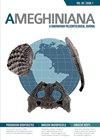阿根廷中西部晚侏罗世棘皮类(棘皮科,棘皮总科):分类和古地理意义
IF 1.5
4区 地球科学
Q3 PALEONTOLOGY
引用次数: 0
摘要
摘要。卡西杜洛德家族在化石记录中的代表性相对较好,特别是在欧洲和北非,尽管它们首次出现在下侏罗纪。该组织在侏罗纪末期表现出多样性和丰富性的增加。在阿根廷,卡西杜洛德人来自中侏罗世的上风。本文描述了一种来自Picun Leufú组(阿根廷Neuqun盆地)的Tithonian Cassiduloid,被确定为Mepygurus?安第斯新梳子。根据欠发达的布尔雷茨的说法,笔直的线条一直延伸到边缘,并有一个次三角形的轮廓。该物种最初是从Neuqun-Aconcagua盆地智利斜坡上的Banios del Flaco地层中描述的。这一记录将属的地层范围扩大到至少Tithonian属,并为解释安第斯地区晚侏罗世浅水台地的空间连续性提供了进一步的证据。总结。自早侏罗世出现以来,特别是在欧洲和北非,壳类动物在化石记录中的代表性相对较好。该群在晚侏罗世表现出多样性和丰度的增加。在阿根廷,他们的代表来自中侏罗世。在这项工作中,描述了被确定为Mepygurus的Picún Leufú组(阿根廷Neuquina盆地)Tithonian的Casiduloidas?安迪纳斯新梳子。根据其发育不全的刺突,直而连续的叶状体到边缘,以及它们的次正交区域。该物种最初是从Neuquina-Aconcaguina盆地智利一侧的Banios del Flaco地层中描述的。这一记录至少将该属的地层范围扩大到蒂森阶,并为解释安第斯地区晚侏罗世浅水平台的空间连续性提供了额外的证据。本文章由计算机程序翻译,如有差异,请以英文原文为准。
Late Jurassic Cassiduloids (Echinodermata, Echinoidea) from West-Central Argentina: Taxonomic and Paleogeographic Implications
Abstract. Cassiduloids are relatively well-represented in the fossil record, especially in Europe and Northern Africa, ever since their first occurrence in the Lower Jurassic. The group shows an increase in diversity and abundance at the end of the Jurassic. In Argentina, cassiduloids are represented from the Middle Jurassic upwards. This paper describes a Tithonian cassiduloid from the Picún Leufú Formation (Neuquén Basin, Argentina) identified as Mepygurus? andinus new comb. according to the poorly developed bourrelets, straight phyllodes that are continuous up to the margin, and a subpentagonal outline. The species was originally described from the Baños del Flaco Formation on the Chilean slope of the Neuquén-Aconcagua Basin. This record extends the stratigraphical range of the genus to at least the Tithonian and provides further evidence to the interpretation of the spatial continuity of shallow-water platforms during the Late Jurassic in the Andean region. Resumen. Los casiduloideos se encuentran relativamente bien representados en el registro fósil desde su aparición en el Jurásico Temprano, especialmente en Europa y norte de África. El grupo muestra un aumento en diversidad y abundancia hacia finales del Jurásico. En Argentina, se encuentran representados a partir del Jurásico Medio. En el presente trabajo se describen casiduloideos del Tithoniano de la Formación Picún Leufú (Cuenca Neuquina, Argentina) determinados como Mepygurus? andinus nueva comb. en función de sus burreletes poco desarrollados, filodes rectos y continuos hasta los márgenes, y de su ámbito subpentagonal. La especie fue originalmente descripta de la Formación Baños del Flaco, en la vertiente chilena de la Cuenca Neuquina-Aconcagüina. Este registro extiende el rango estratigráfico del género por lo menos hasta el Tithoniano y proporciona evidencia adicional para la interpretación de la continuidad espacial de las plataformas de aguas someras durante el Jurásico Tardío de la región andina.
求助全文
通过发布文献求助,成功后即可免费获取论文全文。
去求助
来源期刊

Ameghiniana
地学-古生物学
CiteScore
2.50
自引率
10.00%
发文量
21
期刊介绍:
Ameghiniana is a bimonthly journal that publishes original contributions on all disciplines related to paleontology, with a special focus on the paleontology of Gondwana and the biotic history of the southern hemisphere. Published yearly since 1957, it has undoubtedly become the main palaeontological publication from Latin America. Ameghiniana has recently broadened its editorial board, reorganized its production process, and increased to a bimonthly frequency, which resulted in a significant decrease in the turn around time.
 求助内容:
求助内容: 应助结果提醒方式:
应助结果提醒方式:


